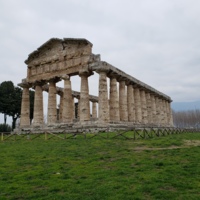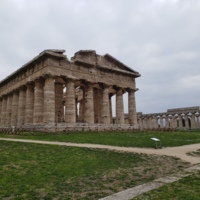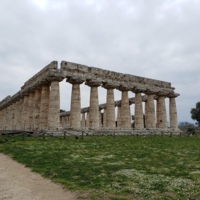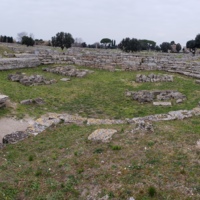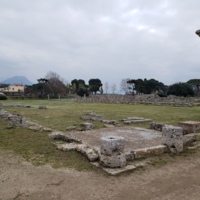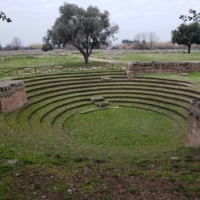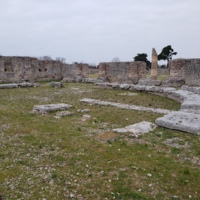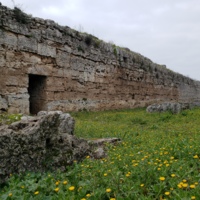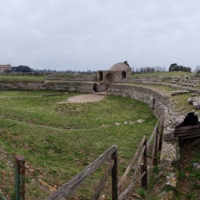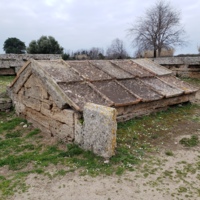Paestum Archaeological Site & Museum
Dublin Core
Title
Paestum Archaeological Site & Museum
Description
Poseidonia (later known as Paestum) was established around 600 BC by colonists from Sybaris, an older Greek colony on the south Italian coast. The town seems to have flourished in the intervening centuries, judging from its significant architectural remains--most famously its three large temples, of which impressive ruins survive.
By 400 BC the city had taken on a large number of Lucanians, an Italian people from the surrounding region that spoke an Oscan language. While ancient authors like Strabo (and many modern authors) depict this as a Lucanian "conquest" or "occupation," most scholars now posit that the two cultures existed side-by-side, producing new, blended traditions (as seen in e.g. their tomb paintings).
From 280-275 BC, the city sided with Pyrrhus of Epirus, a warrior-king who invaded from the Greek east, in his war against Rome. The Romans were ultimately victorious, and Poseidonia/Paestum became the site of a Roman colony in 273 BC. As a Roman colony, the civic architecture significantly changed to fall more in line with Roman models, pointing to the power and influence of the new Roman colonists. The city remained inhabited well into the Roman imperial period and into the early middle ages, though it was gradually abandoned by the seventh century.
By 400 BC the city had taken on a large number of Lucanians, an Italian people from the surrounding region that spoke an Oscan language. While ancient authors like Strabo (and many modern authors) depict this as a Lucanian "conquest" or "occupation," most scholars now posit that the two cultures existed side-by-side, producing new, blended traditions (as seen in e.g. their tomb paintings).
From 280-275 BC, the city sided with Pyrrhus of Epirus, a warrior-king who invaded from the Greek east, in his war against Rome. The Romans were ultimately victorious, and Poseidonia/Paestum became the site of a Roman colony in 273 BC. As a Roman colony, the civic architecture significantly changed to fall more in line with Roman models, pointing to the power and influence of the new Roman colonists. The city remained inhabited well into the Roman imperial period and into the early middle ages, though it was gradually abandoned by the seventh century.
Creator
Gabriel Baker
Rights
Shared under a Creative Commons Attribution-NonCommercial-NoDerivatives 4.0 International License
Collection Items
Temple of Athena
Location: Paestum
Date: c. 500 BC
Details: This archaic Greek temple was built in the Greek colony of Poseidonia (later called Paestum), which was probably established in southern Italy around 600 BC. The remains are one of the oldest standing…
Date: c. 500 BC
Details: This archaic Greek temple was built in the Greek colony of Poseidonia (later called Paestum), which was probably established in southern Italy around 600 BC. The remains are one of the oldest standing…
Temple of Hera (a.k.a. "Temple of Poseidon")
Location: Paestum
Date: 460-450 BC
Details: Originally this temple was identified as a Temple of Poseidon/Neptune, but finds dedicated to Hera (including a silver disk that proclaims "I am sacred to Hera: strengthen our bows"), and sculptures…
Date: 460-450 BC
Details: Originally this temple was identified as a Temple of Poseidon/Neptune, but finds dedicated to Hera (including a silver disk that proclaims "I am sacred to Hera: strengthen our bows"), and sculptures…
Temple of Hera (a.k.a. "The Basilica")
Location: Paestum
Date: 560-520 BC
Details: Originally this temple was identified as a basilica (i.e. a public meeting space), but finds dedicated to Hera (including a silver disk that proclaims "I am sacred to Hera: strengthen our bows"), and…
Date: 560-520 BC
Details: Originally this temple was identified as a basilica (i.e. a public meeting space), but finds dedicated to Hera (including a silver disk that proclaims "I am sacred to Hera: strengthen our bows"), and…
Comitium
Location: Paestum
Date: 273 BC
Details: In 273, the Romans established a Latin colony at Paestum. (The city was originally called Poseidonia, then, after the take over by an Italian people called Lucanians, it was called Paistos, from which name…
Date: 273 BC
Details: In 273, the Romans established a Latin colony at Paestum. (The city was originally called Poseidonia, then, after the take over by an Italian people called Lucanians, it was called Paistos, from which name…
Forum
Location: Paestum
Date: 273 BC
Details: In 273, the Romans established a Latin colony at Paestum. (The city was originally called Poseidonia, then, after the take over by an Italian people called Lucanians, it was called Paistos, from which name…
Date: 273 BC
Details: In 273, the Romans established a Latin colony at Paestum. (The city was originally called Poseidonia, then, after the take over by an Italian people called Lucanians, it was called Paistos, from which name…
Ekklesiaterion or Bouleuterion
Location: Paestum
Date: fifth century BC
Details: In many Greek cities, the ekklesiaterion was a building that hosted meetings of the ekklesia, the assembly of all adult male citizens. The bouleuterion was a building designated for the boule,…
Date: fifth century BC
Details: In many Greek cities, the ekklesiaterion was a building that hosted meetings of the ekklesia, the assembly of all adult male citizens. The bouleuterion was a building designated for the boule,…
Basilica
Location: Paestum
Date: second half of the second century BC
Details: In 273, the Romans established a Latin colony at Paestum. (The city was originally called Poseidonia by its Greek inhabitants.)
As in other Latin colonies, the settlers…
Date: second half of the second century BC
Details: In 273, the Romans established a Latin colony at Paestum. (The city was originally called Poseidonia by its Greek inhabitants.)
As in other Latin colonies, the settlers…
Fortifications
Location: Paestum
Date: the walls visible today were probably built between the late fourth and third century BC, when a Roman colony was established here. However, they may have been preceded by an earlier fortification system.
Details: The…
Date: the walls visible today were probably built between the late fourth and third century BC, when a Roman colony was established here. However, they may have been preceded by an earlier fortification system.
Details: The…
Amphitheater
Location: Paestum
Date: c. 100-50 BC
Details: The amphitheater at Paestum was built in the mid-late first century BC, making it one of the earliest extant Roman amphitheaters, and reflects the growing popularity of these structures in the late…
Date: c. 100-50 BC
Details: The amphitheater at Paestum was built in the mid-late first century BC, making it one of the earliest extant Roman amphitheaters, and reflects the growing popularity of these structures in the late…
Heroon
Location: Paestum
Date: c. 520-510 BC
Details: Greek settlers founded Poseidonia (later called Paestum) around 600 BC. One of the earliest civic structures is the heroon, a square, roofed chamber that was carved out of bedrock near the agora…
Date: c. 520-510 BC
Details: Greek settlers founded Poseidonia (later called Paestum) around 600 BC. One of the earliest civic structures is the heroon, a square, roofed chamber that was carved out of bedrock near the agora…
Collection Tree
- Paestum Archaeological Site & Museum
